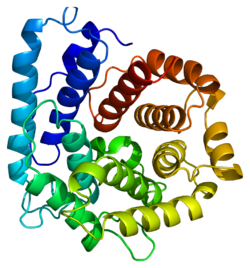- Complement component 3
-
Complement component 3, often simply called C3, is a protein of the immune system. It plays a central role in the complement system and contributes to innate immunity. In humans it is encoded on chromosome 19 by a gene called C3.[1][2]
Contents
Function
C3 plays a central role in the activation of complement system.[3] Its activation is required for both classical and alternative complement activation pathways. People with C3 deficiency are susceptible to bacterial infection.[4][5]
One form of C3-convertase, also known as C4b2a, is formed by a heterodimer of activated forms of C4 and C2. It catalyzes the proteolytic cleavage of C3 into C3a and C3b, generated during activation through the classical pathway as well as the mannan-binding lectin pathway. C3a is an anaphylotoxin and the precusor of some cytokines such as ASP, and C3b serves as an opsonizing agent. Factor I can cleave C3b into C3c and C3d, the latter of which plays a role in enhancing B cell responses. In the alternative complement pathway, C3 is cleaved by C3bBb, another form of C3-convertase composed of activated forms of C3 (C3b) and factor B (Bb). Once C3 is activated to C3b, it exposes a reactive thioester that allows the peptide to covalently attach to any surface that can provide a nucleophile such as a primary amine or a hydroxyl group. Activated C3 can then interact with factor B. Factor B is then activated by factor D, to form Bb. The resultant complex, C3bBb, is called the alternative pathway (AP) C3 convertase.
C3bBb is deactivated in steps. First, the proteolytic component of the convertase, Bb, is removed by complement regulatory proteins having decay accelerating factor (DAF) activity. Next, C3b is broken down progressively to first iC3b, then C3c + C3dg, and then finally C3d. Factor I is the protease that performs these cuts but it requires the help of another protein to supply what is termed cofactor activity.
Structure
Several crystallographic structures of C3 have been determined[6] and reveal that this protein contains 13 domains.[7][8][9][10]
Clinical use
Complement tests C4 (C) FB (A) C3 CH50 Conditions · ↓ ↓ ↓ PSG, C3 NeF AA ↓ · ↓ · HA, C4D · · · ↓ TCPD ↓ · /↓ ↓ ↓ SLE ↑ ↑ ↑ ↑ inflammation Levels of C3 in the blood may be measured to support or refute a particular medical diagnosis. For example, low C3 levels are associated with some types of kidney disease such as post-infectious glomerulonephritis and shunt nephritis.
Interactions
Complement component 3 has been shown to interact with Factor H.[11][12]
References
- ^ de Bruijn MH, Fey GH (February 1985). "Human complement component C3: cDNA coding sequence and derived primary structure". Proc. Natl. Acad. Sci. U.S.A. 82 (3): 708–12. doi:10.1073/pnas.82.3.708. PMC 397115. PMID 2579379. http://www.pnas.org/content/82/3/708.abstract.
- ^ "Entrez Gene: C3 complement component 3". http://www.ncbi.nlm.nih.gov/sites/entrez?Db=gene&Cmd=ShowDetailView&TermToSearch=718.
- ^ Sahu A, Lambris JD (April 2001). "Structure and biology of complement protein C3, a connecting link between innate and acquired immunity". Immunol. Rev. 180: 35–48. doi:10.1034/j.1600-065X.2001.1800103.x. PMID 11414361.
- ^ Lachmann P (December 1975). "Genetics of the complement system". J. Med. Genet. 12 (4): 372–7. doi:10.1136/jmg.12.4.372. PMC 1013316. PMID 768477. http://www.pubmedcentral.nih.gov/articlerender.fcgi?tool=pmcentrez&artid=1013316.
- ^ Matsuyama W, Nakagawa M, Takashima H, Muranaga F, Sano Y, Osame M (December 2001). "Molecular analysis of hereditary deficiency of the third component of complement (C3) in two sisters". Intern. Med. 40 (12): 1254–8. doi:10.2169/internalmedicine.40.1254. PMID 11813855.
- ^ "Advanced search results for UniProt accession P01024". Protein Data Bank in Europe (PDBe). European Bioinformatics Institute. http://www.ebi.ac.uk/pdbe-srv/view/search/index/?Uniprot_accession=P01024. Retrieved 2010-12-27.
- ^ Janssen BJ, Huizinga EG, Raaijmakers HC, Roos A, Daha MR, Nilsson-Ekdahl K, Nilsson B, Gros P (September 2005). "Structures of complement component C3 provide insights into the function and evolution of immunity". Nature 437 (7058): 505–11. doi:10.1038/nature04005. PMID 16177781.
- ^ Janssen BJ, Christodoulidou A, McCarthy A, Lambris JD, Gros P (November 2006). "Structure of C3b reveals conformational changes that underlie complement activity". Nature 444 (7116): 213–6. doi:10.1038/nature05172. PMID 17051160.
- ^ Wiesmann C, Katschke KJ, Yin J, Helmy KY, Steffek M, Fairbrother WJ, McCallum SA, Embuscado L, DeForge L, Hass PE, van Lookeren Campagne M (November 2006). "Structure of C3b in complex with CRIg gives insights into regulation of complement activation". Nature 444 (7116): 217–20. doi:10.1038/nature05263. PMID 17051150.
- ^ Fredslund F, Jenner L, Husted LB, Nyborg J, Andersen GR, Sottrup-Jensen L (August 2006). "The structure of bovine complement component 3 reveals the basis for thioester function". J. Mol. Biol. 361 (1): 115–27. doi:10.1016/j.jmb.2006.06.009. PMID 16831446.
- ^ Soames, C J; Sim R B (Sep. 1997). "Interactions between human complement components factor H, factor I and C3b". Biochem. J. (ENGLAND) 326 ( Pt 2): 553–61. ISSN 0264-6021. PMC 1218704. PMID 9291131. http://www.pubmedcentral.nih.gov/articlerender.fcgi?tool=pmcentrez&artid=1218704.
- ^ Jokiranta, T S; Westin J, Nilsson U R, Nilsson B, Hellwage J, Löfås S, Gordon D L, Ekdahl K N, Meri S (Mar. 2001). "Complement C3b interactions studied with surface plasmon resonance technique". Int. Immunopharmacol. (Netherlands) 1 (3): 495–506. doi:10.1016/S1567-5769(00)00042-4. ISSN 1567-5769. PMID 11367533.
Further reading
-
- Bradley, D T; Zipfel, P F; Hughes, A E (2011). "Complement in age-related macular degeneration: a focus on function". Eye 25 (6). doi:10.1038/eye.2011.37. PMID 21394116.
External links
- GeneReviews/NCBI/NIH/UW entry on Atypical Hemolytic-Uremic Syndrome
- OMIM entries on Atypical Hemolytic-Uremic Syndrome
- GeneReviews/NCBI/NIH/UW entry on Dense Deposit Disease/Membranoproliferative Glomerulonephritis Type II
- MeSH Complement+C3
Proteins: complement system (C, L, A) Activators/enzymes EarlyMiddleLateInhibitors Complement receptors Amyloid Other positive Alpha 1-antichymotrypsin - Alpha 1-antitrypsin - Alpha 2-macroglobulin - C-reactive protein - Ceruloplasmin - C3 - Ferritin - Fibrin - Haptoglobin - Hemopexin - OrosomucoidNegative This article incorporates text from the United States National Library of Medicine, which is in the public domain.
Categories:- Human proteins
- Complement system
Wikimedia Foundation. 2010.

